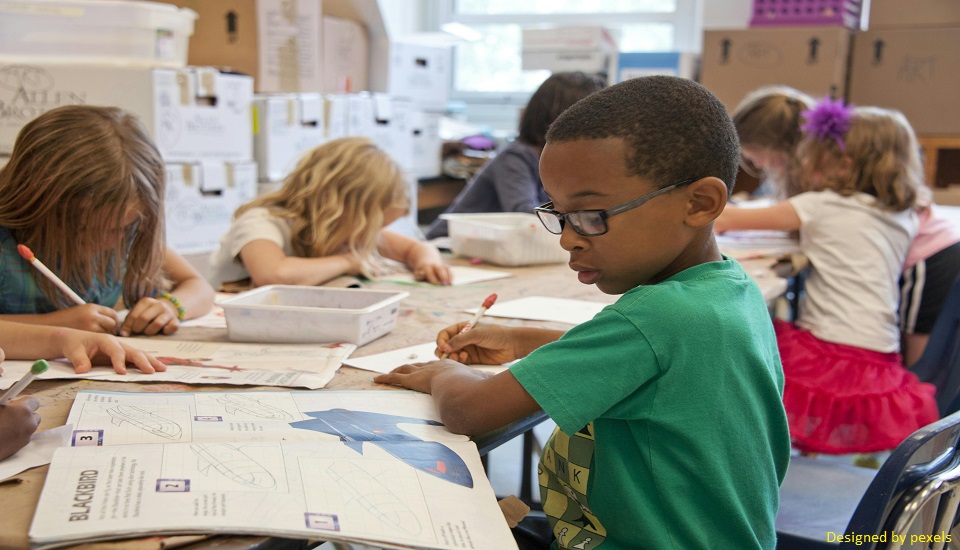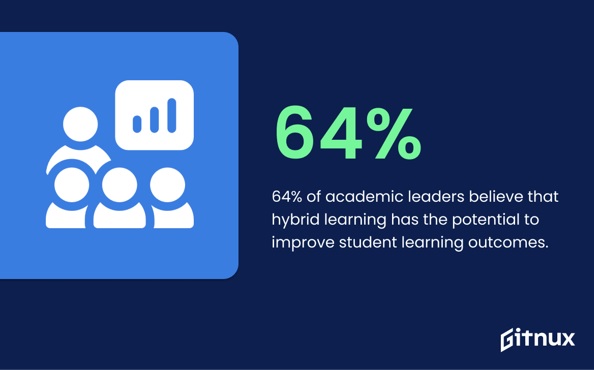6 Effective Ways of How to Create a Successful Hybrid Learning Environment with Specially Designed Instruction
3rd July 2024

Every teacher and school leader faces the challenge of keeping children engaged in the classroom. However, there is an effective strategy to boost student learning engagement and outcomes: the hybrid learning method.
The hybrid learning method is not new and will continue to be used in the future. According to gitnux.org, 64% of academic leaders believe hybrid learning can improve student learning results.

Source: gitnux.org
Some of the strategies you might have employed in the physical classroom are equally applicable in the virtual classroom. Those educators who have pursued courses like Online Special Education Courses, knows it really well.
However, if you're wondering how to create a successful hybrid learning environment through the use of specially designed instruction, then we have you covered. In this blog post, we will be sharing the most effective ways to create a hybrid learning environment with specially designed instruction skills.
Before you move to the topic, can we ask you a quick question? Do you follow us on Social Media? If not, then you’re missing out on a lot of informative content. We regularly share upgraded educational content, tips, feedback, and more. Check us out by clicking the profiles here - Facebook / Twitter / LinkedIn / Pinterest / Instagram / YouTube
What is Specially Designed Instruction?
Specially designed instruction refers to the tailored educational approach employed to assist students with disabilities in achieving their Individualized Education Program (IEP) goals and objectives. As defined by the Individuals with Disabilities Education Act (IDEA), it involves modifying the content, delivery methods, or teaching techniques to meet the unique needs of eligible children.
These targeted differentiation strategies are designed to remove barriers and provide equitable access to grade-level material for all students, including those with learning disabilities, in inclusive classrooms. By embracing specially designed instruction, educators can create an environment that fosters academic success and personal growth for every learner.
The Significance of Hybrid Learning
In today's rapidly evolving educational landscape, hybrid learning has emerged as a powerful approach that blends the best of traditional in-person instruction with the flexibility and convenience of online learning. As schools and educators adapt to the changing needs of students, hybrid classrooms have become an integral part of the educational experience.
By combining face-to-face interactions with virtual learning opportunities, hybrid classrooms offer a unique opportunity to cater to diverse learning styles, accommodate varying schedules, and leverage the power of technology to enhance the teaching and learning process.
Strategies to Elevate Specially Designed Instruction in Hybrid Classrooms
Implementing specially designed instruction in a hybrid setting requires a strategic approach that considers the unique challenges and opportunities presented by this blended learning environment.
By embracing the following strategies, educators can elevate their teaching practices and create an inclusive and engaging learning experience for all students.
1. Identifying Grade-Level Content Objectives
Before embarking on lesson planning, it is crucial to establish clear objectives aligned with the grade-level curriculum. These objectives serve as the foundation for learning, ensuring that all students, regardless of their learning needs or the instructional setting, are working towards mastering the same essential skills and knowledge.
By clearly defining the overarching goals and curricular progression, educators can effectively tailor their instruction to meet the diverse needs of their students while maintaining a consistent focus on the desired learning outcomes.
2. Pinpointing Target Skills
Alongside identifying grade-level content objectives, educators must also determine the specific skills students need to develop to progress through the curriculum successfully. These target skills should not be sacrificed or compromised, regardless of the modifications made to the instructional approach.
For example, when teaching reading, the target skills may vary depending on whether the focus is on fluency, phonological awareness, or comprehension. By clearly defining these skills, educators can design effective instructional strategies that address the unique learning needs of each student while ensuring progress toward mastery.
Learn, 8 Engaging STEM Activities for Kids that Will Foster Curiosity, here:
3. Implementing Comprehensive Pre-Assessments
Before tailoring instruction, it is essential to establish a clear understanding of each student's starting point. Pre-assessments provide invaluable insights into students' baseline knowledge and skills, allowing educators to make informed decisions about the most appropriate instructional strategies and accommodations.
Utilizing a range of assessment methods, such as comprehension tests, screeners, and curriculum-specific assessments, educators can gather data to inform their instructional planning and ensure that learning experiences are tailored to meet the diverse needs of their hybrid classroom.
4. Embracing Multimodal Instruction
Engaging diverse learners in a hybrid setting requires a multifaceted approach that incorporates various modalities, pacing, presentation styles, and instructional strategies. By leveraging multiple modes of delivery, educators can cater to different learning preferences and ensure that all students, whether physically present or participating remotely, have equal opportunities for active participation and engagement.
One effective framework to consider is Universal Design for Learning (UDL), which emphasizes the creation of an accessible and inclusive curriculum through the strategic use of technology and multimedia resources. As many UDL resources are technology-based, these strategies can be particularly beneficial in remote and hybrid learning contexts.
5. Customizing Instructional Adaptations
While differentiation strategies benefit all students, some learners with disabilities may require additional customized adaptations or modifications. These adjustments may be outlined in a student's IEP or may necessitate creative solutions tailored to the unique demands of the hybrid learning environment.
Once these individualized adaptations have been implemented, it is essential to step back and evaluate how these modifications could potentially benefit other students in the classroom. By adopting an inclusive mindset, educators can broaden the reach of their specially designed instruction, creating a more equitable and supportive learning environment for all.
6. Diversifying Assessment Strategies
Assessing student understanding in a hybrid classroom requires a multifaceted approach that leverages various assessment techniques. Conferences, performance tasks, presentations, and observations offer valuable opportunities for students to demonstrate their mastery of the learned material.
Moreover, technology-based accessibility aids, such as dyslexic-friendly fonts, text-to-speech tools, and colour contrast adjustments, can empower students with diverse learning needs to showcase their understanding more effectively. By embracing a range of assessment strategies, educators can gain a comprehensive understanding of each student's progress and tailor their instruction accordingly.
Final Thoughts
Mastering specially designed instruction in hybrid classrooms requires a multifaceted approach that encompasses careful planning, strategic implementation, and ongoing adaptation. By implementing the above-mentioned strategies outlined in this blog post, educators can elevate their teaching practices, foster an inclusive learning environment, and most importantly know how to create a successful hybrid learning environment to empower all students to reach their full potential.
If you want to learn more innovative and effective special education teaching methods. Then, consider pursuing courses like Online Special Education Courses, where you will get assistance from top expert trainers.
We believe education should be accessible for everyone. That’s why we don’t charge for our blogs. Find the right course that will help you in your career with us, contact us at - 1800–212–6400. You can mail us at act@asiancollegeofteachers.com.








